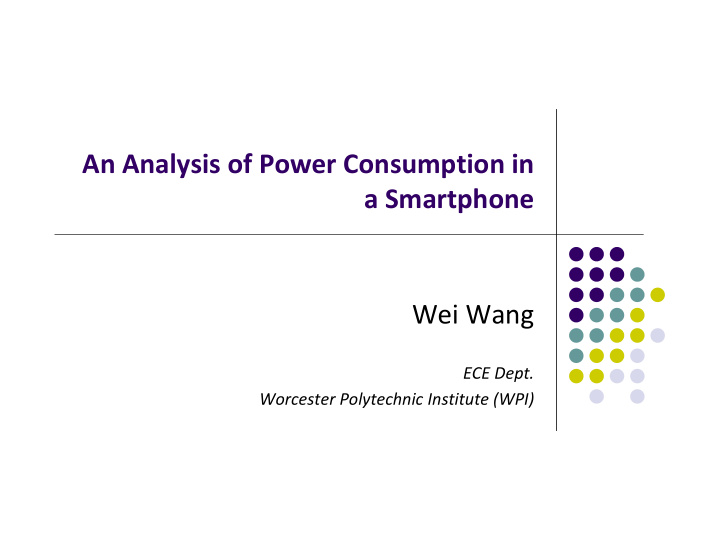



An Analysis of Power Consumption in a Smartphone Wei Wang ECE Dept. Worcester Polytechnic Institute (WPI)
Introduction Energy efficiency of the smartphones is very important, which needs a effective energy management. The core requirement for the energy efficient management is a good understanding of where and how the energy is used. This paper presents a detailed analysis of the power consumption of a recent mobile phone, the Openmoko Neo Freerunner.
Related Work Mahesri and Vardhan analyzed the power consumption on a laptop. Their conclusion is the CPU and display are the main consumer. Bircher and John looked at component power estimation using modeling techniques. Later, Bircher and John measure the power consumption of the CPU, RAM under a number of workload. Sagahyroon used a similar method to analyze the power consumption on a handed PC.
Methodology The approach is to measure the component level power consumption on a real hardware. Three elements: the device ‐ under ‐ test (DuT), a hardware data acquisition (DAQ) system and a host computer. Experimental Setup: Insert sense resistors on the power supply rails of the relevant components to measure the voltage drop with a know resistance. Software: the Android 1.5 (Freerunner) + the power ‐ data collection software (the host computer) to collect raw data from DAQ.
Device under test & Benchmarks Openmoko Neo Freerunner mobile phone, the HTC Dream (G1) and Google Nexus One (N1). Freerunner hardware specifications. Two types of benchmarks: The first series of micro ‐ benchmarks to independently characterize Components of the system. The second series of micro ‐ benchmarks based on real usage scenarios.
Baseline cases Suspended device: the state when the phone is not used. The processor performs a low level of activity but the phone still connects to the network, receive calls and SMS messages… Idle device: the device is fully awake but no applications are active with the backlight turned off.
Micro ‐ benchmarks CPU and RAM Run a subset of the SPEC CPU2000 suite: equake, vpr, gzip, crafty and mcf. For each of the benchmarks, the average CPU and RAM power are measured at fixed core frequencies of 100 MHz and 400 MHz.
Micro ‐ benchmarks Flash storage Two types of flash memory: 256 MiB of internal NAND flash and an external micro Secure Digital card slot. Use the Linux dd program to perform streaming reads and writes. For reads, a 64 MiB file is used. For writes, 8MiB of random data was written.
Micro ‐ benchmarks Network The two main networking components: WiFi and GPRS. Download a file via HTTP using wget. The files were 15 MiB for WiFi and 50 KiB for GPRS. 10 iterations of the benchmark. GPS Enable the module and ran the GPSStatus2 Android application.
Usage Scenarios Audio playback The sample music is a 12.3 MiB, 537 ‐ sec stereo 44.1 kHz MP3 with the output to a pair of stereo headphones. GSM is included and audio file is stored on the SD card. Video playback Use a 5 minutes, 12.3 MiB H.263 ‐ encoded video clip (no sound) and played with Android’s camera application. Text messaging The process consists of loading the contacts application and selecting a contact, typing and sending a 55 ‐ character message, then returned to the home screen.
Usage Scenarios Phone call Making a GSM phone call: loading the dialer application, dialing a number and making a 57 ‐ sec call. Emailing Use Android email application. The workload consists of opening the email application, downloading and reading 5 emails and replying to 2 of them. Web browsing Measure the power consumption of a web ‐ browsing workload using both GPRS and WiFi connections. The benchmark ran for a total of 490 seconds and consists of loading the browser application, selecting a bookmarked web site and browsing several pages.
Usage Scenarios
Usage Scenarios
The HTC Dream (G1) and the Google Nexus One (N1) 246 MHz and 384 MHz on the G1, 245 MHz and 998 MHz on the N1.
Benchmarks Bluetooth Re ‐ Ran the audio benchmark on the G1 with the audio output to a Bluetooth stereo headset.
Analysis The GSM module consumes a great deal of both static and dynamic power. In all except the GSM ‐ intensive benchmarks, the brightness of the backlight is the most critical factor. Overall, the static contribution to system power consumption is substantial. The RAM, audio and flash subsystems consistently show the lowest power consumption.
DVFS & Energy Model
Modeling usage patterns Suspend, Casual, Regular, Business and PMD (portable media device)
Limitations Freerunner is older and lack of 3G cellular interface. The processor is based on ARMv4
Q&A Thanks
Recommend
More recommend